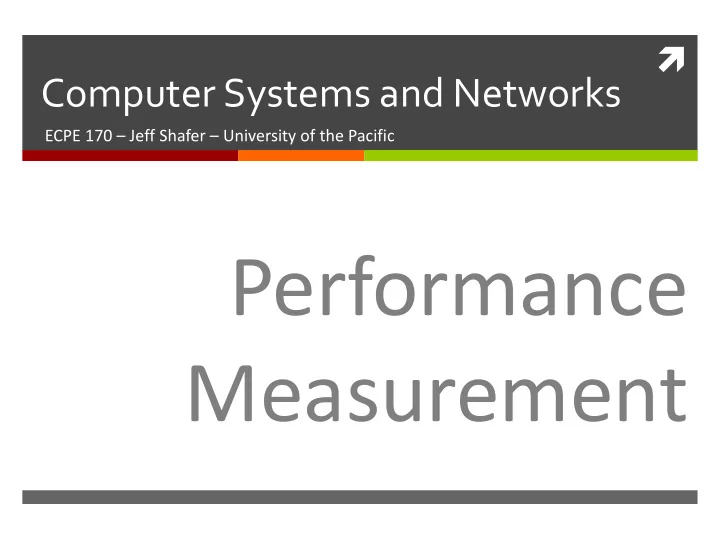

ì Computer Systems and Networks ECPE 170 – Jeff Shafer – University of the Pacific Performance Measurement
2 Lab Schedule Activities Assignments Due Today Lab 4 ì ì Due by Feb 19 th 5:00am Discussion on Performance ì ì Measurement (Lab 5) Lab 5 ì Finish Lab 4! ì Due by Feb 26 th 5:00am ì Next Week ì Lab 5 – Performance ì Measurement Computer Systems and Networks Spring 2019
3 Person of the Day: Bill Joy Co-founder of Sun ì Microsystems Author of vi text editor ì Key contributor to original ì BSD Unix while a Berkeley grad student First open-source OS with ì TCP/IP Computer Systems and Networks Spring 2019
4 ì Memory Leaks Computer Systems and Networks Spring 2019
5 Problem 1 int main() { int *array; array=(int *)malloc(sizeof(int)*1000); for(i=0;i<1000;i++) array[i] = i; return 0; } Where is the Memory Leak? P1 Computer Systems and Networks Spring 2019
6 Problem 2 int main() { int **array; array=(int **)malloc(sizeof(int *)*1000); for(i=0;i<1000;i++) array[i] = (int *)malloc(sizeof(int)*500); free(array); return 0; } (a) Where is the Memory Leak? P2 (b) How do you fix it? Computer Systems and Networks Spring 2019
7 ì Performance Measurement Computer Systems and Networks Spring 2019
8 Lab 5 Goals Measure program execution time 1. Break down program execution time by specific 2. subroutines / lines of code Monitor program for memory leaks 3. Not really “performance”, but uses same tool ì Computer Systems and Networks Spring 2019
9 Performance Measurement ì Why is it important to measure application performance in detail ? Computer Systems and Networks Spring 2019
10 Valgrind http://valgrind.org/ Computer Systems and Networks Spring 2019
11 Valgrind Features ì Memcheck module – Memory error detector ì Access 1 beyond the beginning / end of your array? ì Access un-initialized memory? ì Reading/writing memory after calling free()? ì Memory leak? (Lost pointer to a malloc() block) ì Valgrind produces a report that identifies these errors Computer Systems and Networks Spring 2019
12 Valgrind Features ì Callgrind module – Program profiler ì Callgraph shows you what function called what other functions ì How much CPU time does each function / code line consume? ì Valgrind produces a report that summarizes CPU usage of your program Computer Systems and Networks Spring 2019
13 Valgrind Features ì Massif module – Heap profiler Optimize your program to use less memory ì (by identifying where memory is being used) ì Helgrind module – Threading profiler Bugs in multi-threaded programs are especially ì difficult to find! ì … and more modules … Computer Systems and Networks Spring 2019
14 Valgrind Common Uses ì Your program runs and suddenly segfaults Recall a segfault means a memory address was ì accessed that doesn’t exist for your program ì How do I find where this error is? Valgrind can monitor your program and detect ì accesses outside of static variables and dynamic memory regions Computer Systems and Networks Spring 2019
15 Valgrind Common Uses ì Your program gets slower and slower the longer it runs Memory leak? (Slowing running out of heap ì memory because you malloc() without ever calling free()) ì How do I find where this error is? Valgrind can monitor your program. It can’t tell you ì where you should free it, but it will tell you where you originally called malloc(), or where the pointer was lost Computer Systems and Networks Spring 2019
16 Valgrind Behind-the-Scenes ì Just-in time compiler Your program is re-compiled onto a virtual ì (simulated) processor Another example of a virtual machine! ì ì Benefit – Valgrind can observe your program running at the machine instruction level ì Drawback – Slow! (5x slower than normal) But it’s still better than fixing bugs without a tool… ì Computer Systems and Networks Spring 2019
17 ì Profiling Basics Computer Systems and Networks Spring 2019
18 Profiling Basics ì The next labs (5-7) ask you to measure application performance by conducting experiments Execution time ì Processor usage ì Memory usage ì ì Which of these system configuration do you think would be best in terms of producing the cleanest, most accurate, most reproducible results? Computer Systems and Networks Spring 2019
19 Program to Benchmark Computer Systems and Networks Spring 2019
20 Program to Benchmark Computer Systems and Networks Spring 2019
21 Program to Benchmark Computer Systems and Networks Spring 2019
22 Profiling Basics ì The best approach (directly booting Linux) may not be convenient to achieve for this class ì But you can *definitely* avoid the worst configuration! Keep your system simple when benchmarking ì Computer Systems and Networks Spring 2019
Recommend
More recommend